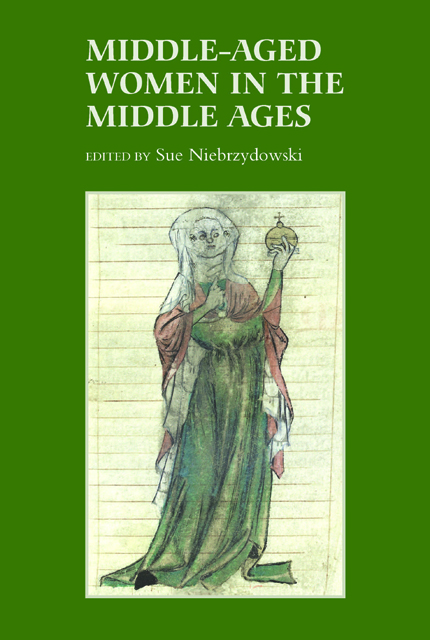Book contents
- Frontmatter
- Contents
- List of Plates
- Abbreviations
- Contributors
- Introduction: ‘Becoming bene-straw’: The Middle-Aged Woman in the Middle Ages
- 1 The Age of Discretion: Women at Forty and Beyond
- 2 Seeking the Middle-Aged Woman in Medieval Wales
- 3 Middle Age in Romance? Magic, Enchantment and Female Power
- 4 Age and Desire in the Old English Life of St Mary of Egypt: A Queerer Time and Place?
- 5 The St Albans Psalter: Sex, Desire and the Middle-Aged Woman
- 6 Speaking Volumes: the Middle-Aged Woman and the Book in Medieval England
- 7 ‘Late hir seye what sche wyl’: Older Women’s Speech and the Book of Margery Kempe
- 8 Preparing for Mature Years: the Case of Margaret of Anjou and her Books
- Select Bibliography
- Index
2 - Seeking the Middle-Aged Woman in Medieval Wales
Published online by Cambridge University Press: 14 February 2023
- Frontmatter
- Contents
- List of Plates
- Abbreviations
- Contributors
- Introduction: ‘Becoming bene-straw’: The Middle-Aged Woman in the Middle Ages
- 1 The Age of Discretion: Women at Forty and Beyond
- 2 Seeking the Middle-Aged Woman in Medieval Wales
- 3 Middle Age in Romance? Magic, Enchantment and Female Power
- 4 Age and Desire in the Old English Life of St Mary of Egypt: A Queerer Time and Place?
- 5 The St Albans Psalter: Sex, Desire and the Middle-Aged Woman
- 6 Speaking Volumes: the Middle-Aged Woman and the Book in Medieval England
- 7 ‘Late hir seye what sche wyl’: Older Women’s Speech and the Book of Margery Kempe
- 8 Preparing for Mature Years: the Case of Margaret of Anjou and her Books
- Select Bibliography
- Index
Summary
Any discussion of middle-aged women in medieval Wales has the advantage of being able to draw on not only the historical sources, most notably the law codes, but also the rich literature of the period. However, the topic is fraught with hidden pitfalls, since it hides a number of questions and assumptions within it. When, for example, would a woman be considered middle-aged in medieval Wales? Did the category even exist? If it did, was the position of a middle-aged woman to be pitied or to be envied? How were such women treated? There are a number of examples of middle-aged women to explore, both in historical and literary texts, and the way that they are presented in the contemporary material is the subject of this essay, in an attempt to answer at least some of these questions. The focus of the essay will be on women in medieval Welsh literature and law codes.
‘Gwreic Wyf Fi’: Transition to Womanhood and Middle Age in Medieval Welsh Literature
The title of this section includes a quotation from one of the Four Branches of the Mabinogi, the four most important medieval Welsh prose tales. The particular quote, ‘gwreic wyf fi’ (‘I am a woman’), is taken from the fourth branch, Math uab Uathonwy, the longest and possibly most complex of the four branches. Math fab Mathonwy was a demi-god, or at least a wizard, and also the king of Gwynedd, the main kingdom in north Wales throughout the Middle Ages. According to the tale, Math has a peculiarity which means that he is unable to live unless he has his feet permanently on a virgin’s lap (the exceptions are when war prevents him from being in this position). His virgin is named as Goewin, daughter of Pebin. However, in the story a man from his court, Gilfaethwy, falls in love with Goewin, and with his brother Gwydion (also a magician) plots to obtain her.
- Type
- Chapter
- Information
- Middle-Aged Women in the Middle Ages , pp. 25 - 36Publisher: Boydell & BrewerPrint publication year: 2011

